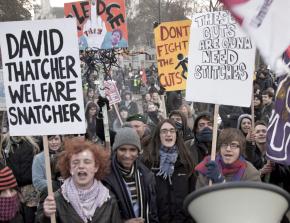Their fear of democracy
Tens of thousands of students took to the streets around Britain last Thursday for Day X3 protests against a government plan to nearly triple student fees while cutting education spending. An estimated 20,000 poured into Parliament Square and the surrounding areas as lawmakers inside voted on the Conservative-Liberal Democrat coalition government's proposal.
The measure passed in the House of Commons, but by only 21 votes. The Tories and Liberal Democrats together have a parliamentary majority of more than 80 seats, but pressure from the protests caused dozens of Liberal Democrats--which pledged during the election campaign earlier this year to not just oppose student fee increases, but scrap them altogether--to vote against the government's proposal.
Police once again stepped up the level of repression against demonstrators, including the use of its tactic of hemming in protesters and refusing to let them leave for hours--a practice known in Britain as "kettling." Outside parliament, mounted police repeatedly charged their horses into the ranks of demonstrators, causing at least one severe injury and dozens of more minor ones. Yet the mainstream media's outrage was saved for a group of protesters who briefly surrounded a car carrying Prince Charles and wife Camilla and apparently gave the royals a fright.
, author of The Liberal Defence of Murder and a blogger at Lenin's Tomb, analyzes the government's new repressive tactics and what they say about the effectiveness of the protest movement.
DAVID CAMERON demands that the "mob" must be punished. The Metropolitan police are in trouble with the "party of order," who are aghast, simply aghast, that the royal Daimler has been scuffled by oiks. The Met blames and condemns "the outrageous and increasing levels of violence that some of the protesters are now involved in."
Now there is casual talk of using firearms, as if it is only virtue and the "restraint" of armed officers and security officials that prevents those protesters from getting their heads justly blown off.
The frenzy has been as relentless as it is familiar. The established players know their lines well. Their royal we-ness maintain a dignified, somewhat bemused silence, while the Rottweilers go to work, ostensibly on their behalf.
Yes, you have a perfect democratic right to protest, they say with patronizing assurance, but violence is intolerable and will not be tolerated. Yes, most people were peaceful, but there were some people determined to resort to destruction. And those who flout the law must be exposed to the full penalty of the law. And, well, under difficult circumstances, some officers may lash out to protect themselves and their colleagues, and someone may be injured or die as a result. And the state will, if anything, err obsessively on the side of probity, subjecting those poor officers to investigation before finding them completely innocent.

We are probably witnessing a move to retool the state, the better to cope with civil disobedience and strikes. Police have deployed a strategy of provoking violent confrontations with small bands of protesters. By using preemptive kettling, by charging at protesters with mounted police, by staging baton charges and by lashing out at peaceful protesters with almost lethal force, the police have set up physical confrontations.
They have then attempted to use their overwhelming superiority of organization and force to coerce protesters into retreating into preemptively kettled territory. This would galvanize a small minority who would physically seek to break out, but would be effectively held back. Thus, intimidated and physically coerced, they would come to resent the minority isolated as "professional troublemakers" and wait meekly to go home in the late hours of a chill December evening, resolving never to attend a protest again.
This strategy is based on the assumption that protests break down into a well-meaning but duped and passive mass, and a nefarious, organized conspiracy of upstarts, and that the police can pry the two apart.
BUT IT didn't actually go down like that. Most of those protesters who did end up in direct combat with the cops are, as Paul Mason points out, working-class 16- and 17-year-olds from Britain's banlieues. They are not the committed anarchists that the law-and-order mob are braying about, and they were not resented by other protesters.
More worryingly for the police, when they did attempt to baton charge, they were often effectively resisted. Using whatever ad hoc instruments were at their disposal, large numbers of protesters physically outmaneuvered police on numerous occasions. Sometimes, for example, they used the same crowd-control barriers that were intended to pen them to push back ranks of baton-wielding, helmeted and shielded riot police. And when the police attacked people, they often fought back. They were not cowed, despite the physically imposing stature and superior weaponry of the cops, and despite the horrifying record of the Territorial Support Group.
So far from protesters blaming a small minority of troublemakers for the violence, they are almost unanimous in reporting that the police engineered the violence. And because the police didn't get it all their own way, the FT's headline today was: "Police lose control of street protests."
Now the language of the "mob" is back in vogue, and the prospect of lethal violence against protesters cheerfully bruited. Now the state is worried that the protests have started to be effective, and might become even more effective in future. Now they're worried about what might be unleashed. The technologies of repression and containment need to be updated for an age when it isn't as easy to fabricate a serious division among protesters, between cunning manipulators and a gulled majority.
The government is having to play a game of catch-up. It introduced 16 percent cuts to policing in its spending review, suggesting that it anticipated a relatively easy ride over the cuts, and that it wouldn't need the particular loyalty of police departments. And if these protests were flash-in-the-pan, localized and self-contained, that calculation might have a modicum of realism to it. But they have proven to be anything but. They have accelerated and spread, and added new energy and vigor to every anti-cut campaign, every left-wing party and coalition, every meeting and rally in the country.
Now a Conservative leadership that hasn't had a serious fight on its hands since the early to mid-1990s is having to run to the police for help, and I suspect that means the police are about to get a lot of new powers and perhaps a relief in some of the cuts coming their way.
Inevitably, the "mob"--the subject of official invective--is depicted as an opponent not merely of a policy, but of "democracy." But democracy is not law and order. Democracy is the mob; the mob is democracy.
DEMOCRACY IS supposed to mean popular sovereignty, not the unimpeded rule of a no-mandate government. It is supposed to mean that the will of the majority governs, not the interests of the rich. It is supposed to mean at minimum that people get the policies they vote for, not those they are overwhelmingly hostile to.
In liberal democratic theory, the people are sovereign inasmuch as their aspirations and prerogatives are effectively mediated through a pluralist party-political state. They may not get all that they want all of the time, but the decision-making process will be guided by the public mood, which rival parties must compete to capture and express.
Yet this system has only ever been effective to the limited extent that it has been when it has been supplemented by militant extra-parliamentary pressure--by the threat of disruption to stable governance and profit-accumulation. To the extent that the parliamentary system is ever really democratic, it is parasitic on a much more fundamental popular democracy.
Frances Fox Piven (along with her late partner Richard Cloward) has long argued that the electoral-representative system is most democratic when the working class and the poor are deliberately disruptive--when they are organized, but not institutionalized.
This distinction is made in a particular way that it's important to get right. By "institutionalized," Piven means incorporated into the state. Thus, the lesson of the 1930s, she argues, is that the working class was most effective when it withdrew its participation, went on strike, took wildcat action, performed sit-ins, etc. The bosses of the big steel companies and car manufacturers responded, just as the federal government did, by trying to institutionalize industrial action, turning it into a regulated, far more predictable and manageable occurrence, and incorporating organized labor into a deliberately de-escalating machinery.
But there are other examples of being institutionalized in this negative sense--being incorporated into a parliamentarist or electoralist machinery, for example. Or you might add being co-opted by conservative NGOs, wherein politics becomes a kind of showmanship, a spectacle where the main thing that counts is media reception and public relations. Whatever happens, you become absorbed into the tacit rules that actually reproduce social power, rather than effectively rebelling against it.
By contrast, what Piven calls "disruptive power" is that which shuts down processes and events that make capital and the state run efficiently. Closing down a main road with a sit-down protest is an example of this. Occupying a public building, or flash-mobbing a retail outlet, or blockading a nuclear facility, are also examples of disruptive power. Withdrawing one's labor is another, and picketing to obstruct the effective utilization of the means of production is another.
This disruptive power doesn't have to be particularly noisy or violent or attention-grabbing in and of itself. Nor is it necessary that it should be meek, amiable and nonviolent. Any question of noise and street theatre is a secondary tactical question, and any violence is a matter of exigency rather than principle. But what "disruptive power" exploits is the fact that economic and political power in complex capitalist societies rely on a series of intricate interdependencies and specializations, which distributes the capacity to disrupt the system rather widely.
Different agencies will be better placed to exploit this than others, because they are differently endowed with the relevant structural capacities, and each situation involving this capitalist or that state authority will open up different opportunities. And there will always be subjective difficulties in adapting the repertoire of learned methods of resistance to any new situation. But the exercise of this disruptive power has been the hallmark of the "mob" throughout history, and it has also accompanied every democratic breakthrough.
We are now in a situation where the ruling classes are uneasily realigning their forces, scrutinizing their techniques of dominance, restless about their ability to hold the line in the new situation. Meanwhile, we are coming out of a generation that has spent many years going through defeats, and only occasional and partial victories, and we are trying to find out what works and what does not.
Listening to protesters, you hear people say that the lesson of the last decade is that the tactic of the big march and rally didn't work, even with over a million people and more in attendance. The media spectaculars didn't work either, even with Snoop Dogg in attendance. So now people are trying out occupations, sit-down protests, flash-mobs and other forms of disruptive protest. They are learning what their legal position is if they do protest, and if they're arrested. They're learning how to handle the press.
The question of what kinds of industrial action is most effective looms over us again. The one-day general strike? Sustained, indefinite walkouts by strategically important groups of workers? Recurring strikes of lengthening duration? And what kind of picketing is effective? How to handle the media and the police? What to accept in negotiations? And so on.
The mob is re-learning, applying and reinventing the principles of democracy. And the law is having once again to prepare itself to resist the threat of democracy.
First published at Lenin's Tomb.


